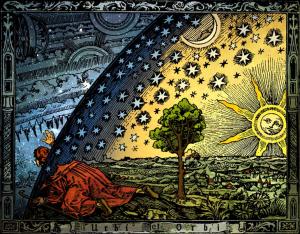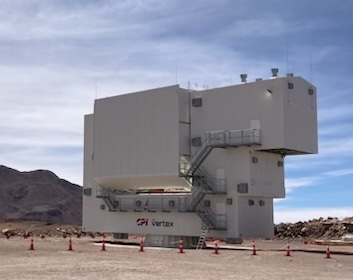Registration for May is on Eventbrite and by phone. 412-321-2400. Please leave a message with your name, number of tickets (one or two), and a call back number.

When Gravity meets Particle Physics
by Dr. Rachel Rosen, Department of Physics, Carnegie Mellon University
7:00 Doors open, Light Refreshments
7:20 Student Presentation by Vincent Niedermayer, University of Pittsburgh
7:30 Lecture
Tour and Observing (weather dependent) to follow.
Reservations are required and may be made on Eventbrite or by calling the observatory at 412-321-2400. They will be accepted beginning at 1:00P.M. the Monday following the previous lecture. Please Note: Due to the overwhelming demand and the limited space for the public lectures only 2 reservations can be made per person. Only 30 people who've attended the previous lecture can sign up for the next lecture, the rest of the available reservations will be reserved for people who have not attended the previous lecture.
If you make a reservation and cannot attend please cancel either through Eventbrite or by calling so someone else can take your place.
This historic building is partially handicapped accessible. Please email Allegheny-Observatory@Pitt.edu or call 412-321-2400 with any questions.
- January 17th
-

"I first met Anna when they were a freshman at Ohio State with a TEDx talk already under their belt. In Pittsburgh, while home from college for the summer, Anna was hired by Pitt to do astronomy outreach with me at CMU. We had so much fun, tabling at the Zoo, talking on the radio, connecting with amateur astronomers and teachers, and ending the summer with Anna becoming the youngest person ever to give an astronomy talk in the Allegheny Observatory Astronomy Lecture Series. Anna went on to win the Ohio State President's Award ($100,000), a Brooke Owens Fellowship and was awarded a 2021 Future Space Leaders Grant. Anna worked with Anousheh Ansari, the first Muslim woman in space, and the blind astronomer, Wanda Díaz-Merced before founding AstroAccess and SciAccess, to bring "together a diverse community of researchers, professionals, students, educators, employers, and disability rights advocates, whose shared knowledge and ideas are critical to increasing skills, knowledge, and opportunities in STEM fields for individuals with disabilities" and brought many disability ambassadors aboard the Zero-G aircraft to experience and study weightlessness. Anna Voelker is someone to watch as their rocket aims for the stars, doing their best to bring the rest of us along for the ride."
-Diane TurnshekStudent presentation: Esme Offner, Allderdice High School
HR diagram of M34
- February 21st

Illustration from Camille Flammarion's L'atmosphère : météorologie populaire Carles Badenes, Physics and Astronomy Department, University of Pittsburgh
How big is the Universe? A historical perspective.
- March 21st

Image from Encyclopedia Britannica Anna O'Grady
McWilliams Center for Cosmology, Carnegie Mellon University
A Buddy for Betelgeuse: Searching for the companion of the nearest Red Supergiant
- April 18th

Illustration: Maciej Rębisz for Quanta Magazine Magnetars: The Universe's Most Magnetic Marvels
Mohit Bhardwaj, McWilliams Center for Cosmology, Carnegie Mellon University
- May 16th
-

When Gravity meets Particle Physics
It’s often claimed that gravity (General Relativity) and particle physics (Quantum Field Theory) are fundamentally incompatible with each other. In this talk I’ll discuss why this common lore can be misleading. However, I will also present some of the deepest mysteries in theoretical physics that lie at the intersection of gravity and particle physics.
Rachel Rosen, Department of Physics, Carnegie Mellon University
- June 20th

SNR 0519-69.0 composite image, credit X-ray: NASA/CXC/GSFC/B. J. Williams et al.; Optical: NASA/ESA/STScI Blast from the Past: Using Supernova Remnants to Learn about their Explosions
Travis Court, Physics and Astronomy, University of Pittsburgh
- July 18th
-
Marcell Howard, Physics and Astronomy, University of Pittsburgh
- August 15th
-
Accordion content 2.
- September 19th

Arthur Kosowsky
Physics and Astronomy, University of Pittsburgh
The Next Great Microwave Observatory
- October 17th
-
Brendan Mullan
Physics, Carnegie Mellon University
Growing up in the Galaxy: The search for life and our future in the cosmos.
- November 21st
-
Rachel Bezanson
Physics and Astronomy, University of Pittsburgh
2024
- January 19th

FULL - Waitlist active
Detecting Gravitational Waves With Pulsars
Dr. Arthur Kosowsky
Department of Physics and Astronomy, University of Pittsburgh
- February 16th

Credit: Jingchuan Yu, Beijing Planetarium Fast Radio Bursts
Dr. Jeff Peterson
Department of Physics, Carnegie Mellon University
- March 15th
-

Women Who Looked Up
Dr. Linda Kucan
University of Pittsburgh School of Education
Outreach Update
Kerry Handron
Allegheny Observatory
- April 19th
-

Solar Eclipses, Shadow Bands, and Balloon Launches
Dr. Sandhya Rao
Department of Physics and Astronomy, University of Pittsburgh
- May 17th
-

Cosmic Inflation: Now and Then
Dr. Andrew Zentner
Department of Physics and Astronomy, University of Pittsburgh
- June 21st
-

Cosmic Cartography: Making the Largest Maps of our Universe
Biprateep Dey
Department of Physics and Astronomy, University of Pittsburgh
- July 19th
-

Twists and Turns while Searching for Strange Stars
Anna O'Grady
Department of Physics, Carnegie Mellon University
- August 16th
-

Exploring and Utilizing the Moon in a Commercial Context
Eric Fischer, Officer in the AAAP and Gallery Host at Moonshot Museum
- September 20th
-

The Future of Astronomy
Diane Turnshek
Department of Physics, Carnegie Mellon University
- October 18th
-

Astrobotic
- November 15th

Astronomers estimate 50,000 sources of near-infrared light are represented in this image from NASA’s James Webb Space Telescope. Their light has travelled through varying distances to reach the telescope’s detectors, representing the vastness of space in a single image.
Credits: NASA, ESA, CSA, I. Labbe (Swinburne University of Technology) and R. Bezanson (University of Pittsburgh). Image processing: Alyssa Pagan (STScI)Update: Peering into the Distant Universe with the New James Webb Space Telescope
Rachel Bezanson, Department of Physics and Astronomy, University of Pittsburgh
Student Presentation: Genevieve Sweterlitsch, Astronomy and Art
2023
- January 20th, 2023
-
Exoplanets
Sandhya Rao
Department of Physics and Astronomy, University of Pittsburgh
- February 17th, 2023
-
The Darkest Dark Matter
Andrew Zentner, Department of Physics and Astronomy, University of Pittsburgh
- March 17th, 2023
-
A New Era: How Space Telescopes will show us the Sites and Sights of Galaxy Formation
Gourav Khullar, Department of Physics and Astronomy, University of Pittsburgh
- April 21st, 2023
-
The Impact of Satellites on Observational Astronomy
Diane Turnshek
Department of Physics, Carnegie Mellon University
- May 19th, 2023
-
Seeking the Invisible: In Search of a New Physics to Illuminate Dark Matter
Valentina Dutta, Department of Physics, Carnegie Mellon University
- June 16th, 2023
-
Turning to the Light Side by Smashing Particles
Matteo Cremonsi, Department of Physics, Carnegie Mellon University
- July 21st, 2023

European Space Agency The Gaia Revolution: Our New View of the Milky Way
Andrew Pace, Department of Physics, Carnegie Mellon University
- August 18th, 2023
-

M82 Composite from Chandra, HST and Spitzer The Tumultuous Lives of Galaxies
Evan Schneider, Department of Physics and Astronomy, University of Pittsburgh
- September 15, 2023

Surrounded by a sparkling sea of stars, the Milky Way extends over ESO's Very Large Telescope facility.
Credit:
J. Busqué/ESOThe True Colors of the Milky Way
Brett Andrews, Department of Physics and Astronomy, University of Pittsburgh
- October 20, 2023
-

A Man Who Loved the Stars: John A. Brashear
Edward Michael Potosky, Allegheny Observatory, University of Pittsburgh
- November 17, 2023

Astronomers estimate 50,000 sources of near-infrared light are represented in this image from NASA’s James Webb Space Telescope. Their light has travelled through varying distances to reach the telescope’s detectors, representing the vastness of space in a single image.
Credits: NASA, ESA, CSA, I. Labbe (Swinburne University of Technology) and R. Bezanson (University of Pittsburgh). Image processing: Alyssa Pagan (STScI)Update: Peering into the Distant Universe with the New James Webb Space Telescope
Rachel Bezanson, Department of Physics and Astronomy, University of Pittsburgh
